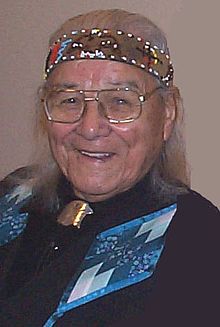Contents

Kitigan Zibi Anishinabeg ("Garden River People")[1] is an Algonquin First Nation in Quebec, Canada. It is based in the Outaouais region and owns one Indian reserve named Kitigan Zibi, located on the shores of the Gatineau River near Maniwaki. In 2018, it has a total registered population of 3,286 members.[2]
Politics
The Kitigan Zibi Anishinabeg are governed by a band council elected according to an election system based on Section 11 of the Indian Act. For 2020-2022 tenure, the chief of this council is Dylan Whiteduck.[3]

Languages
According to Statistics Canada's 2011 Census, on a total population of 1,395, 36.2% knew an indigenous language. More precisely, 25.4% had an indigenous language still spoken and understood as first language and 21.1% spoke an indigenous language at home. Regarding Canada's two official languages, 43% knew both English and French, 54.8% knew only English and 2.1% knew only French.[4] Concerned about the disinterest of its youth in their own language, the community has decided to reintroduce the teaching of the Algonquin language in school.[5]
As of the 2016 census of those living on the Kitigan Zibi reserve:[6]
- 20.7% learned their indigenous language as their first language.
- 17.4% spoke an indigenous language at home.
- 31% had knowledge of an indigenous language.
- 59.5% spoke only English out of the official languages.
- 2.4% spoke only French out of the official languages.
- 37.6% spoke both English and French.
List of chiefs
The chiefs have been:[7]
- Chief Antoine Pakinawatik - 1854-1874
- Chief Peter Tenasco - 1874–1884, 1890–1896
- Chief Simon Odjick - 1884-1890
- Chief Louizon Commanda - 1896-1899
- Chief John Tenasco - 1899-1911
- Chief Michael Commanda - 1911-1917
- Chief John Cayer - 1917-1920
- Chief John B. Chabot - 1920–1924, 1939–1951
- Chief Vincent Odjick - 1927-1933
- Chief Patrick Brascoupe - 1933-1936
- Chief Abraham McDougall - 1936-1939
- Chief William Commanda - 1951-1970
- Chief Ernest McGregor - 1970-1976
- Chief Jean Guy Whiteduck - 1976-2006
- Chief Stephen McGregor - 2006-2008
- Chief Gilbert Whiteduck - 2008-2015
- Chief Jean-Guy Whiteduck - 2015–2020
- Chief Dylan Whiteduck - 2020–Present
Culture and tourism
The Kitigan Zibi Pow wow is held annually on the first weekend of June. The Kitigan Zibi Cultural Centre has a number of exhibits, cultural artifacts, paintings, and photographs relating to the Algonquin culture and history. A living museum, Mawandoseg Kitigan Zibi, is dedicated to the Anishinaabeg way of life.[8]
Notable members
- Claudette Commanda, university professor and 15th Chancellor of the University of Ottawa.
- Nadia Myre, interdisciplinary artist
- Joshua Odjick, actor
References
- ^ "ARTIST Claude Latour". V tape. Retrieved 14 August 2023.
- ^ "Registered Population". Crown–Indigenous Relations and Northern Affairs Canada. Government of Canada. Retrieved 9 March 2018..
- ^ "Kitigan Zibi elects new chief, band council". CBC News. Retrieved 1 September 2020..
- ^ "Language characteristics". Crown–Indigenous Relations and Northern Affairs Canada. Government of Canada. Retrieved 9 March 2018..
- ^ "Kitigan Zibi (Réserve indienne)" (in French). Commission de toponymie du Québec. Retrieved 2012-10-26.
- ^ Languages characteristics of the Kitigan Zibi Anishinabeg First Nations at Indigenous and Northern Affairs Canada. Retrieved 2021-07-19.
- ^ "History – Kitigan Zibi". Kitigan Zibi Anishinabeg. Kitigan Zibi. 2021. Retrieved 8 November 2021.
- ^ "The Algonquin Communities: Kitigan Zibi Anishinabeg". Anishinabe Nation. Algonquin Anishinabeg Nation Tribal Council. 2016. Retrieved 2020-08-26.
External links
- kitiganzibi
.ca - Kitigan Zibi Anishinabeg website - Kitigan Zibi Anishinabeg community home page Archived 2012-07-23 at the Wayback Machine
- First Nation Detail by Indigenous and Northern Affairs Canada

